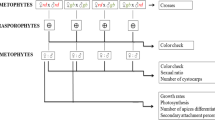Abstract
Crossing experiments were carried out between artificial pigmentation mutants and the wild type in Porphyra haitanensis Chang et Zheng to ascertain where meiosis occurs in its life history by confirming whether the color segregation and the color-sectored blades appear in F1 gametophytic blades developed from conchospores which are released from heterozygous conchocelis. Two red-type pigmentation mutants (R-10 and SPY-1) were used as the female parent. Their blades are red or red orange in color, thinner than the wild type and weak in elasticity, and have no denticles on their margins. The wild type (W) was used as the male parent; its blades are light brown in color, thick and good in elasticity, and have many marginal denticles. The F1 gametophytic blades developed from conchospores which were released from heterozygous conchocelis produced in the crosses of R-10(♀)×W(♂) and SPY-1(♀)×W(♂) showed two parental colors (R and W) and two new colors (R', lighter in color than R; W', wild-type-like color and redder than W). Linear segregation of colors occurred in the F1 blades, forming color-sectored blades with 2–4 sectors. In the color-sectored blades, R and R' sectors were thinner than W and W' sectors, and had weak elasticity and no denticles on their margins, whereas W and W' sectors were thick and had good elasticity and many marginal denticles. Of the F1 gametophytic blades, 95.2–96.7% were color-sectored and only 3.3–4.8% were unsectored. These results indicate that meiosis of P. haitanensis occurs during the first two cell divisions of a germinating conchospore, and thus it is considered that the initial four cells of a developing conchosporeling constitute a linear genetic tetrad leading to the formation of a color-sectored blade. The new colors of R' and W' were recombinant colors due to the chromosome recombination during the first cell division in meiosis. It is considered that color phenotypes of the two mutants used in this paper were result of two (or more) recessive mutations in different genes, and that they also have mutations concerned with blade thickness and formation of marginal denticles, which are linked with the color mutations.
Similar content being viewed by others
References
Aruga Y (1974) Color of cultivated Porphyra thalli. Our Nori Res. 23: 47–61.
Aruga Y (1980) Color and the pigments of Porphyra yezoensis. Iden 34(9): 8–13.
Aruga Y, Miura A (1984) In vivo absorption spectra and pigment contents of the two types of color mutants of Porphyra. Jpn. J. Phycol. 32: 243–250.
Fujian Fisheries Bureau (1979) Artificial cultivation of Porphyra haitanensis. Fujian People Publishing House, Fuzhou, China, pp. 1–101.
Kobara T, Miura A, Aruga Y (1976) In vitro studies on the green type mutant of Porphyra yezoensis Ueda. La Mer 14: 58–63.
Mitman GG, van der Meer JP (1994) Meiosis, blade development, and sex determination in Porphyra purpurea (Rhodophyta). J. Phycol. 30: 147–159.
Miura A (1975) Studies on the breeding of cultivated Porphyra (Rhodophyceae). The 3rd International Ocean Development Conference, August 5–8, 1975, Tokyo. Preprint Volume III. Marine Resources: 81–93.
Miura A (1985) Genetic analysis of the variant color types of light red, light green and light yellow phenotypes of Porphyra yezoensis (Rhodophyta, Bangiales). In Hara H (ed.), Origin and Evolution of Diversity in Plants and Communities. Academia Scientific Book, Tokyo, pp. 270–284.
Miura A (1990) Present trends and perspective in Porphyra (Nori) breeding. Genetics of pigmentation mutants in Porphyra yezoensis: Development origin of variegated gametophytic thalli. Suisan Ikushu 15: 19–30.
Miura A, Kunifuji Y (1980) Genetic analysis of the pigmentation variants in Porphyra yezoensis. Iden 34(9): 14–20.
Miura A, Shin JA (1989) Cross breeding in cultivars of Porphyra yezoensis Ueda (Bangiales, Rhodophyta). A preliminary report. Korean J. Phycol. 4: 207–211.
Niwa K, Miura A, Shin JA, Aruga Y (1993) Characterization and genetic analysis of the violet type pigmentation mutant of Porphyra yezoensis Ueda (Bangiales, Rhodophyta). Korean J. Phycol. 8: 217–230.
Ohme M, Kunifuji Y, Miura A (1986) Cross experiments of the color mutants in Porphyra yezoensis Ueda. Jpn. J. Phycol. 34: 101–106.
Ohme M, Miura A (1988) Tetrad analysis in conchospore germlings of Porphyra yezoensis (Rhodophyta, Bangiales). Plant Sci. 57: 135–140.
Ohme M (1989) Genetics of Porphyra yezoensis. Kaiyo 21: 350–354.
Saito M, Araki S, Sakurai T, Oohusa T (1975) Variations in contents of photosynthetic pigments, total nitrogen, total free amino acids and total free sugars in dried lavers obtained at different culture grounds and harvesting time. Bull. Jpn. Soc. Sci. Fish. 41: 365–370.
Shin JA (1992) Thremmatological studies on the cultivated Porphyra yezoensis Ueda. Ph.D thesis, Tokyo University of Fisheries, Tokyo, Japan, 74 pp.
Wang SJ, Zhang XP, Xu ZD, Sun YL (1986) Studies on the cultivation of the vegetative cells and protoplasts of Porphyra haitanensis Chang et Zheng. Ocean. et Limnol. Sinica 17(3): 217–221.
Yan XH, Aruga Y (1997) Induction of pigmentation mutants by treatment of monospore germlings with NNG in Porphyra yezoensis Ueda (Bangiales, Rhodophyta). Algae 12: 39–52.
Yan XH, Aruga Y (2000) Genetic analysis of artificial pigmentation mutants in Porphyra yezoensis Ueda (Bangiales, Rhodophyta). Phycol. Res. 48: 177–187.
Yan XH, Fujita Y, Aruga Y (2000) Induction and characterization of pigmentation mutants in Porphyra yezoensis Ueda (Bangiales, Rhodophyta). J. Appl. Phycol. 12: 69–81.
Yan XH, He LH, Aruga Y (2005) A chromosomal study on Porphyra haitanensis Chang et Zheng (Bangiales, Rhodophyta). Ocean. et Limnol. Sinica (in press).
Yan XH, Li L, Chen JH, Aruga Y (2003) Genetics and breeding of Porphyra haitanensis Chang et Zheng (Bangiales, Rhodophyta). Proceedings of the First Forum of High-Tech for Marine Organisms, held by the National High Technology Research & Development Program of China ("863" Program), Zhoushan, China, July 22–25, pp. 107–113.
Author information
Authors and Affiliations
Corresponding author
Rights and permissions
About this article
Cite this article
Yan, Xh., Li, L. & Aruga, Y. Genetic analysis of the position of meiosis in Porphyra haitanensis Chang et Zheng (Bangiales, Rhodophyta). J Appl Phycol 17, 467–473 (2005). https://doi.org/10.1007/s10811-005-2752-7
Received:
Accepted:
Published:
Issue Date:
DOI: https://doi.org/10.1007/s10811-005-2752-7




